
Teacher | Writer | Traveler
Turkey Adventure with Phyllis: May 8 - 19, 2014

The Blue Mosque is a superb example of Ottoman architecture.
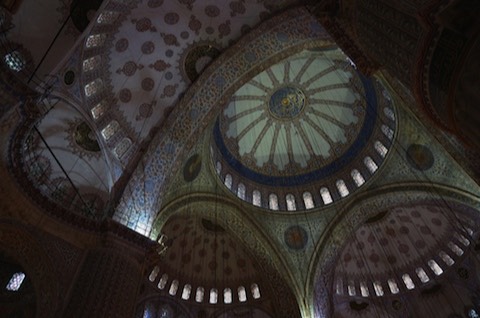
The Blue Mosque: Looking up into the domes, with its 42,000 blue tiles.

The Aya Sophia is now a museum, having once been a church converted into a mosque.
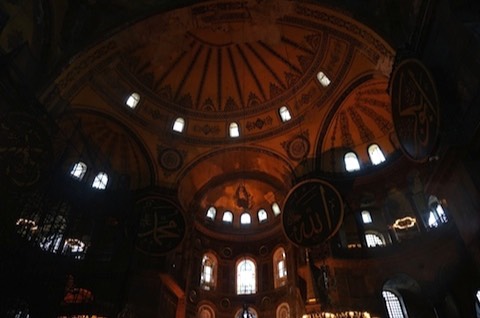
The Aya Sophia: Looking up at the dome inside the building.

Istanbul on European shore east of Golden Horn. Istanbul is a city of 17 million people, striding both Europe and Asia.

The Spice Market, Downtown Istanbul.

Our Guide: Ertan Asar.
Yes, it rained the 3 days we were in Istanbul!

Bosphorus Cruise: An afternoon cruise along the Bosphorus hugging the European shore: a high rent area.

The Bosphorus along the Asian shore: much sought-after real estate, for millionaires only.

Dinner in an Ottoman restaurant in Istanbul with Ranch instructor Erin Kessel and her son.

The Australian Memorial at Gallipoli.

Troy: The entrance to the archaeological site.

Ampitheatre, Troy: Remains of a large city with forums, palaces, amphitheatres, market place, and stadium.

Pergamon: Ampitheatre.

Acropolis of Pergamon.

Ferry Across the Dardenelles: Car, bus, and passenger Ferry from Canukkale to Asian Turkey. A beautiful day.

Sunset over the Dardenelles.

Ephesus: An amazing Roman city with well-preserved remnants of its former glory. You could feel the energy of the place and imagine the people living there. They even had public toilets!

Ephesus: The library.

Ephesus: Ampitheater.

Ephesus: public toilets. Running water channeled under the seats.

Stork nesting on a flag pole.

A small church dedicated to the Virgin Mary who died here.

Aegean Sea, viewed from hotel room.
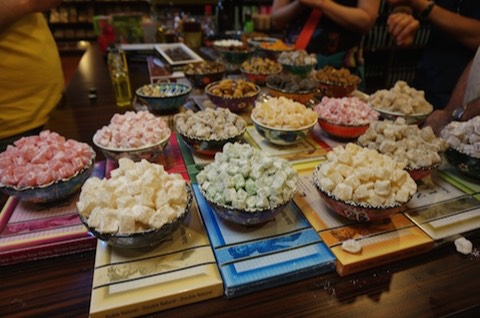
Turkish Delight: every flavor: lemon, ginger, honey . . .
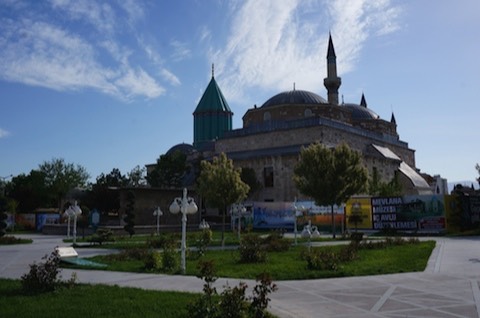
Mausoleum for Rumi in Konya, Central Turkey.
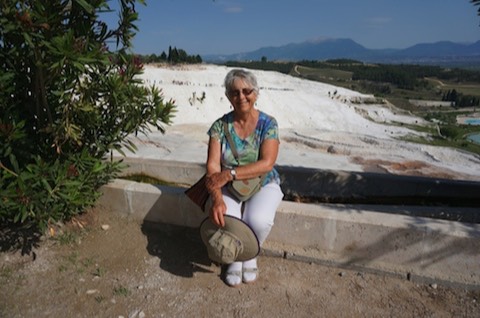
Pamukkale mineral springs and mineral deposits on hillsides. Hot springs well up out of the earth and pour down the hillsides, leaving white mineral deposits over the landscape,forming terraces and waterfalls.
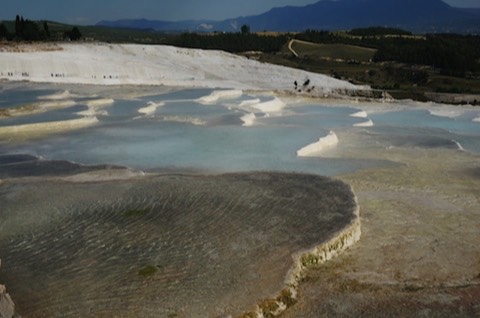
Pamukkale: Travertine terraces.

Mineral spring terraces glinting in afternoon sunshine.
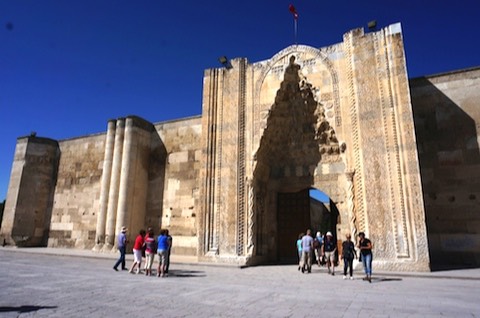
Konya: Caravensera entrance.
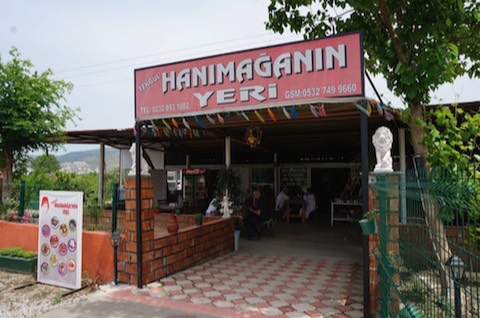
Lunch at a small Turkish cafe: home cooking.
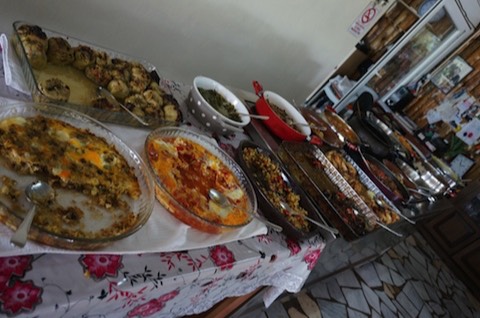
Lunch at a small Turkish cafe: home cooking.
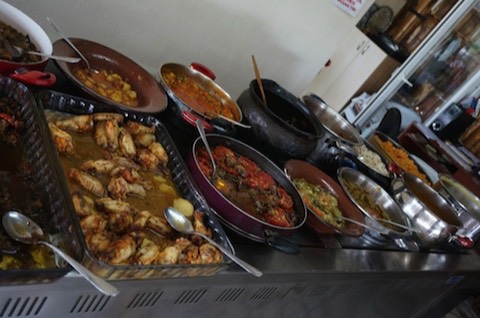
Lunch at a small Turkish cafe: home cooking.
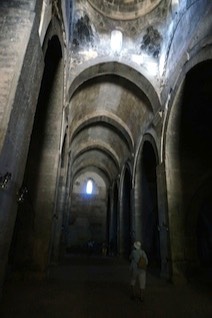
Caravensera interior: Safe haven for camel caravans to overnight.
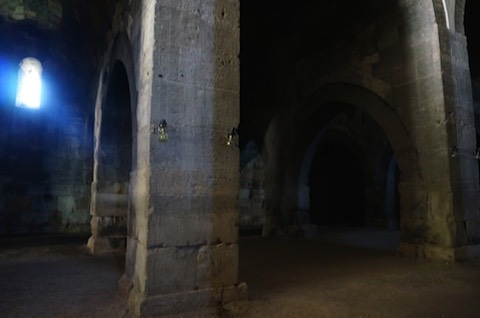
Caravensera interior.

Caravensera interior.
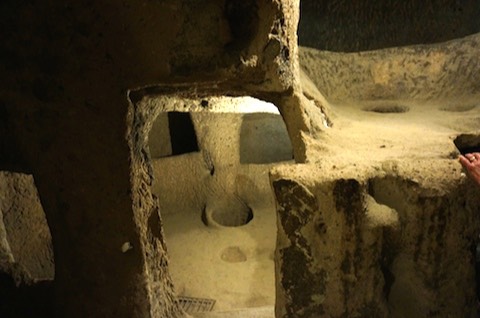
Underground City: Carved out of Tuffa volcanic conglomerate.
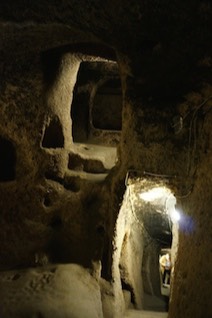
Cappadocia: underground city, with connecting tunnels and rooms.
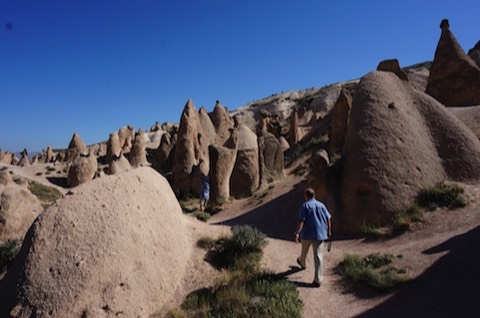
A hike through the "fairy chimneys."
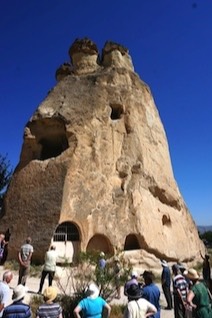
A monk's cave cut out of the tuff in a fairy chimney.
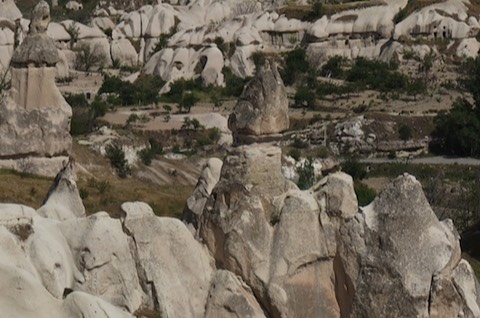
Cappadocia: Goreme's fairy chimneys.
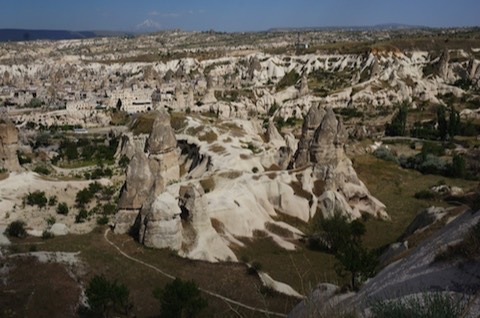
Cappadocia: Tuffa erosional landscapes with "fairy chimneys."
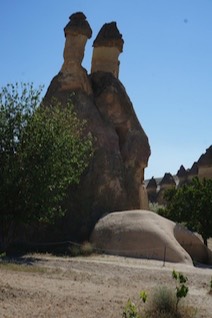
Cappadocia: tuffa formation in Goreme.
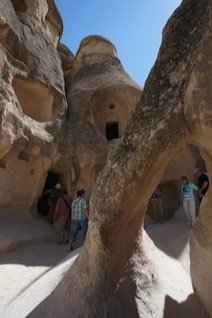
Cappadocia: Churches carved out of tuffa.
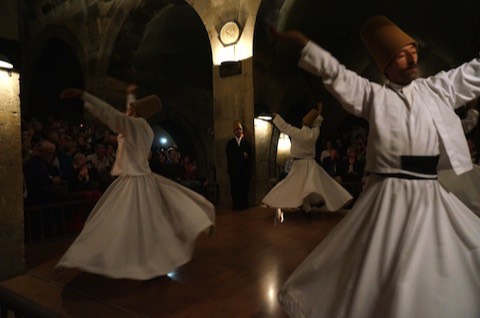
Cappadocia: Whirling Dervishes performing in a caravansera.
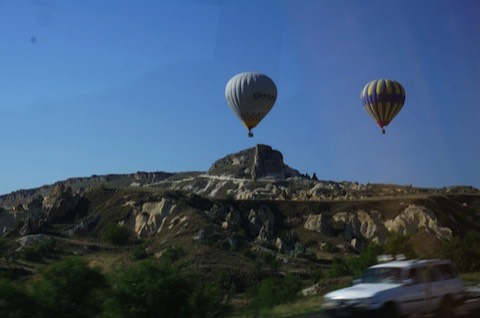
Cappadocia: Early morning hot air balloon rides over Goreme.
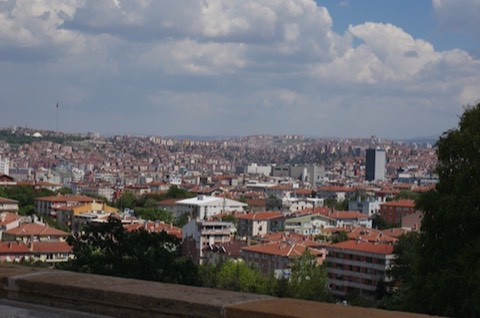
Ankara: Capital of Turkey.
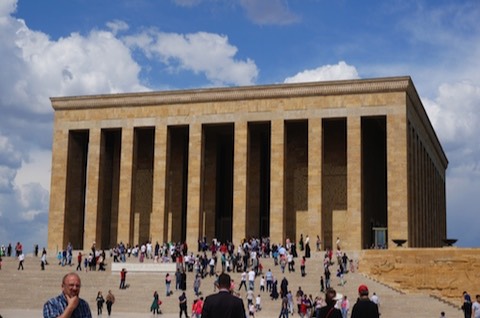
Ankara: Kemal Ataturk's Mausoleum.

Ankara: We leave Turkey on Independence Day, May 19.
My Trip to Turkey.
May 8 - 19, 2014 (by Phyllis)
An amazing trip indeed: an 11-day tour around western Turkey . . .
Starting in Istanbul, we stayed in the old city and visited nearby Aya Sofia, a museum now converted from the Ottoman mosque which in turn had converted it from the Byzantium Cathedral built in 800 AD. Layers of architecture and art surviving the changes of culture are preserved on the walls as a museum today. The beauty of the original interior and huge central dome with its lesser side domes is awe inspiring when gazing up into it, so spacious and beautiful.
The nearby Blue Mosque too is exquisite, with its more than 42,000 blue tiles on the inside domes and walls to give it its name. The diffusion of color, light, and spaciousness offers not only beauty to the eye but upliftment to the spirit: Ottoman art and architecture at its most exquisite. We explored the Golden Horn and cruised along the Bosphorus, admiring the million-dollar homes along its shores; explored the large covered Market with more than 4000 shops; and bought saffron in the Spice Market.
We visited just about every archeological site in and around Istanbul and along the Aegean coast: Gallipoli, Troy, Ephesus, Pergamon and more before heading inland along the Meander River climbing onto the central plateau area. The layers of different civilizations stacked on top of each other was evident in each of the carefully excavated sites.
Leaving Istanbul, we travelled by coach along the north shore of the Sea of Marmara to Galipoli to see the sites of this terrible battle field, then crossed The Dardenelles at the car ferry port of Cannukkale. We visited Ephesus, which is truly eye opening and magnificent, giving a rich impression of what Roman life here might have been like with its avenues, baths and toilets, market places and shops, the library, and its magnificent amphitheater.
The geography and vegetation changes spectacularly with lush well-tended farmlands, with a great variety of Mediterranean crops: grapes, strawberries which we enjoyed in abundance, orchards of peaches, plums, and nut trees. We also crossed paths with travelers following in the footsteps of St. Paul and visited the Church of the Virgin Mary who died in this area.
For most of this inland route, we followed one of the many roads of the famed Silk Route. The higher plateau offers spectacular geographical volcanic sites like the hot spring area of Pamukkale, with its spectacular travertine terraces deposited by the minerals in the milky warm water flowing over the hillsides, and Cappadocia with "fairy chimneys" and underground cave dwellings dug out of tuffa, compacted volcanic ash deposited millions of years ago from nearby dormant volcanoes subsequently eroded into this fantastic landscape. To escape persecution, Early Christians dug out underground cities, 10 stories deep, with interconnecting tunnels, rooms, air ducts and small chapels housing as many as 10,000 people. Only recently have they been discovered and excavated for public viewing.
We visited the large city of Konya and its magnificent mausoleum and museum to honor Rumi, locally known as Mendevi, much revered in Turkey. I loved visiting there and learning all about his life and teachings where he also introduced the discipline of the whirling dervishes: a very rigorous training and practice much respected, taught and practiced in Konya and throughout Turkey.
One of the largest and best preserved caravansary, ornately built like a huge fort, is located in Konya, built in the 15th century where the silk route traders camped overnight with hundreds of camels carrying their goods between China and the Mediterranean. We stopped to see inside and tried to imagine life overnighting in many such as these, traveling along the Silk Route.
A highlight was attending a genuine "performance" of the whirling dervishes in a converted caravansary in Cappodocia, performed truly as a spiritual discipline. A very moving experience. We were allowed to make a movie or take photos after the main practice was over, when a short excerpt was repeated for us to photograph.
We ended or trip in Ankara, the capital of Turkey, visiting the tomb of Kemal Ataturk, the founder of modern Turkey in 1924 after the fall of the Ottoman Empire. We departed Ankara, bedecked with large Turkish flags on all public buildings to celebrate their anniversary of Independence on May 19.
May 8 - 19, 2014 (by Phyllis)
An amazing trip indeed: an 11-day tour around western Turkey . . .
Starting in Istanbul, we stayed in the old city and visited nearby Aya Sofia, a museum now converted from the Ottoman mosque which in turn had converted it from the Byzantium Cathedral built in 800 AD. Layers of architecture and art surviving the changes of culture are preserved on the walls as a museum today. The beauty of the original interior and huge central dome with its lesser side domes is awe inspiring when gazing up into it, so spacious and beautiful.
The nearby Blue Mosque too is exquisite, with its more than 42,000 blue tiles on the inside domes and walls to give it its name. The diffusion of color, light, and spaciousness offers not only beauty to the eye but upliftment to the spirit: Ottoman art and architecture at its most exquisite. We explored the Golden Horn and cruised along the Bosphorus, admiring the million-dollar homes along its shores; explored the large covered Market with more than 4000 shops; and bought saffron in the Spice Market.
We visited just about every archeological site in and around Istanbul and along the Aegean coast: Gallipoli, Troy, Ephesus, Pergamon and more before heading inland along the Meander River climbing onto the central plateau area. The layers of different civilizations stacked on top of each other was evident in each of the carefully excavated sites.
Leaving Istanbul, we travelled by coach along the north shore of the Sea of Marmara to Galipoli to see the sites of this terrible battle field, then crossed The Dardenelles at the car ferry port of Cannukkale. We visited Ephesus, which is truly eye opening and magnificent, giving a rich impression of what Roman life here might have been like with its avenues, baths and toilets, market places and shops, the library, and its magnificent amphitheater.
The geography and vegetation changes spectacularly with lush well-tended farmlands, with a great variety of Mediterranean crops: grapes, strawberries which we enjoyed in abundance, orchards of peaches, plums, and nut trees. We also crossed paths with travelers following in the footsteps of St. Paul and visited the Church of the Virgin Mary who died in this area.
For most of this inland route, we followed one of the many roads of the famed Silk Route. The higher plateau offers spectacular geographical volcanic sites like the hot spring area of Pamukkale, with its spectacular travertine terraces deposited by the minerals in the milky warm water flowing over the hillsides, and Cappadocia with "fairy chimneys" and underground cave dwellings dug out of tuffa, compacted volcanic ash deposited millions of years ago from nearby dormant volcanoes subsequently eroded into this fantastic landscape. To escape persecution, Early Christians dug out underground cities, 10 stories deep, with interconnecting tunnels, rooms, air ducts and small chapels housing as many as 10,000 people. Only recently have they been discovered and excavated for public viewing.
We visited the large city of Konya and its magnificent mausoleum and museum to honor Rumi, locally known as Mendevi, much revered in Turkey. I loved visiting there and learning all about his life and teachings where he also introduced the discipline of the whirling dervishes: a very rigorous training and practice much respected, taught and practiced in Konya and throughout Turkey.
One of the largest and best preserved caravansary, ornately built like a huge fort, is located in Konya, built in the 15th century where the silk route traders camped overnight with hundreds of camels carrying their goods between China and the Mediterranean. We stopped to see inside and tried to imagine life overnighting in many such as these, traveling along the Silk Route.
A highlight was attending a genuine "performance" of the whirling dervishes in a converted caravansary in Cappodocia, performed truly as a spiritual discipline. A very moving experience. We were allowed to make a movie or take photos after the main practice was over, when a short excerpt was repeated for us to photograph.
We ended or trip in Ankara, the capital of Turkey, visiting the tomb of Kemal Ataturk, the founder of modern Turkey in 1924 after the fall of the Ottoman Empire. We departed Ankara, bedecked with large Turkish flags on all public buildings to celebrate their anniversary of Independence on May 19.